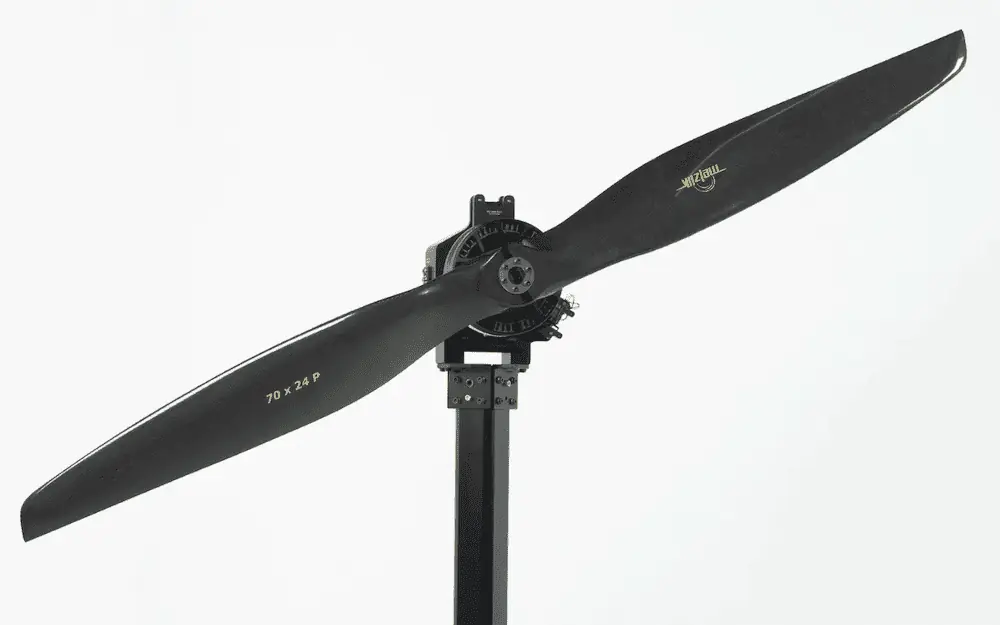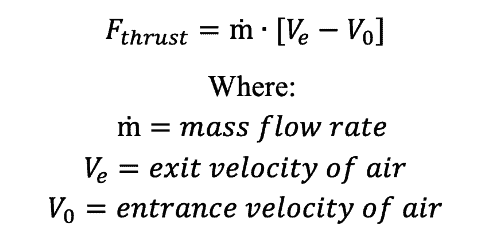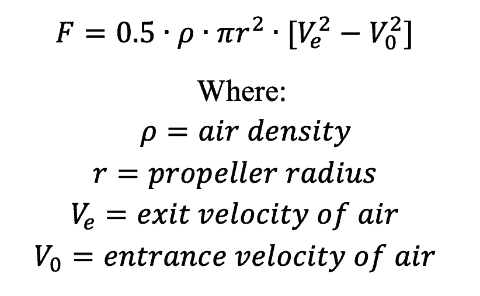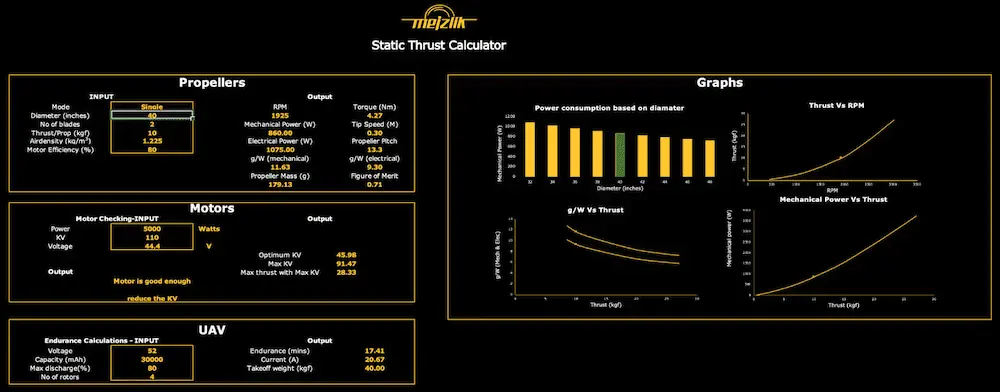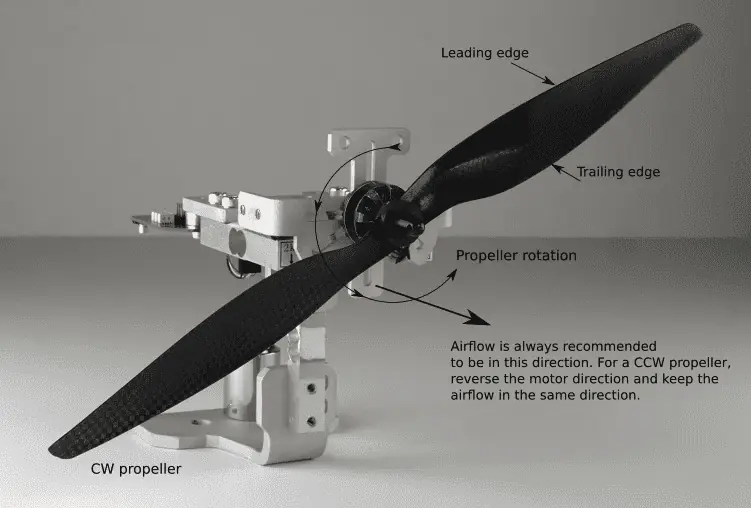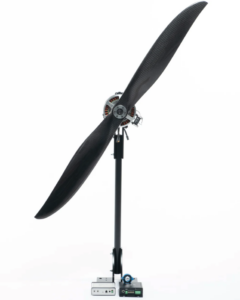In the below article, Tyto Robotics looks at three different methods for quantifying propeller thrust and compares the results.
The methods covered include the propeller thrust equation, propeller thrust calculator, and how to use a thrust stand to measure propeller thrust.
Calculating propeller thrust is a useful part of the aircraft design process. It can help you choose the right components and determine your limits for useful load.
Calculations are based on assumptions and will only take you so far, which is why we recommend using a thrust stand to measure propeller thrust in order to validate calculations.
In this article we will cover both the theoretical side that relies on equations and assumptions, and the practical side that uses physical testing to obtain true values. We will also show you how to use a propeller thrust calculator that estimates performance based on your inputs and real propeller data.
Table of Contents:
- Propeller thrust equation
- Propeller thrust calculator
- How to measure propeller thrust with a thrust stand
- Example: comparing thrust from the calculator and thrust stand
Figure 1: Flight Stand 150 propeller thrust stand
Propeller Thrust Equation
Propeller thrust is dependent on the properties of the propeller and the air around it. This can be expressed in a few different ways.
We will first look at an equation for static propeller thrust, for a propeller that is stationary in a no wind condition.
Then we will look at an equation for dynamic propeller thrust.
Static Propeller Thrust Equation
First, thrust is dependent on the mass flow rate of the air and the change in air velocity:
The mass flow rate can be expressed in terms of the air density, air velocity at the propeller, and the area covered by the propeller:
Therefore we can rewrite the equation for propeller thrust as:
While Ve and V0 can be measured, Vp is harder to quantify. We can solve for this by thinking about thrust as the force on the propeller disk, which is equivalent to the change in pressure across the disk times the area:
and:
Therefore:
So in order to calculate propeller thrust, we need the air density, the radius of the propeller, and the air velocity entering and exiting the propeller.
Dynamic Propeller Thrust Equation
When calculating dynamic propeller thrust, we have to consider the forward airspeed of the propeller / aircraft, as well as the RPM and propeller dimensions:
This equation was derived by Electric Aircraft Guy. It uses propeller diameter, pitch, propeller forward airspeed, and RPM.
He has applied correctional constants to bring the results closer to data he measured, but he estimates it will still underestimate thrust by 15-30%.
Propeller Thrust Calculator
Mejzlik Propellers offers static and dynamic thrust calculators, which can be used to estimate the thrust produced by a propeller.
The way the calculators work is by interpolating data based on the performance of propellers Mejzlik has tested. According to their website, this covers multicopter propellers ranging from 10’’ to 48’’ in diameter.
Static Propeller Thrust Calculator
To calculate static thrust, all you need to enter is:
- Diameter
- # of blades
- Thrust/ prop
- Air density
- Motor efficiency
We used this calculator to find out how much weight a drone can carry. Here’s what the interface looks like:
Dynamic Propeller Thrust Calculator
The dynamic calculator requires the following:
- Motor inputs (Io, Rm, KV, ESC efficiency)
- Propeller diameter
- Propeller pitch
- Air density
- Drag
- Aircraft speed
The calculators generate graphs comparing thrust and efficiency at different RPM values. They also estimate power consumption and compare your results with those for similar propeller sizes.
It can be a great tool if you’re asking yourself: “what size of propeller do I need for my build?” and need a place to start.
The calculators come with the following disclaimers:
- They are limited to multicopter propellers, so you cannot adjust the propeller pitch (an optimal pitch is chosen for you)
- The RPM and power values are applicable for Mejzlik multicopter propellers only
- The accuracy is reduced as the # of blades increases
- Motor data should be verified with the manufacturer
How to Measure Propeller Thrust with a Thrust Stand
If you really want to know how much thrust a propeller can produce, the best thing to do is to test it. Our thrust stands support static and dynamic testing, so we’ve got you covered no matter what you need to measure.
Here’s what you’ll need in order to test your propeller’s thrust:
- Propeller
- Motor
- ESC / motor controller
- Thrust stand
- Power source
- Testing software
Once you’ve gathered the equipment you need, it’s time to set-up your thrust test:
- Secure the thrust stand to a hard surface
- Attach your ESC and motor to the thrust stand
- Attach your propeller to your motor
- Connect the thrust stand to the power source and software
- Control the thrust stand with the software and watch the data come in.
In this video we show you how to perform this set-up, plus we use a wind generator to get dynamic results that are extra realistic:
For propeller testing, you’ll most likely be interested in propeller thrust data as well as propeller efficiency, both of which are recorded by the software.
Here’s an example of what the exported data looks like:
Example: Comparing Thrust From the Calculator and Thrust Stand
Let’s use an example to see how the results of these two methods compare.
Let’s say we have a 48” 2-blade propeller and the average air density is 1.225 kg / m3.
We recently discovered that the average max efficiency of a brushless motor is about 78%, so we will assume that is our motor’s efficiency.
For this example we will use the static thrust calculator and a stationary thrust stand without a wind tunnel.
Propeller Thrust Calculator Results
We can enter these numbers into the static propeller thrust calculator to estimate our propeller’s thrust:
It tells us that at an RPM of 1880, our thrust is 20 kgf.
It also provides a short table with estimated RPM and thrust values, plus a graph of their relationship (figure 7).
Thrust Stand Results
We used our Flight Stand 50 for this test, which can measure up to 50 kgf of thrust and 30 Nm of torque.
We performed a ramp test from 0 to 2000 RPM with a 48” propeller.
We exported the test data and selected points based on the RPM values given in the thrust calculator’s table. We plotted them side by send and added trend lines, which can be seen in figure 7 below.
Interestingly, the thrust calculator underestimated the performance of the propeller. At all RPM values, the thrust measured by the thrust stand was higher than that estimated by the calculator.
This is generally the preferred scenario, rather than the calculator overestimating performance and the aircraft underperforming.
This difference is likely caused by slight differences in the propeller – the one we used may have a different pitch than what is assumed by the calculator.
It goes to show that if you want to know the true thrust and performance of your propeller, physical testing is the way to go.
Conclusion
In conclusion, there are many ways to estimate the thrust produced by your propeller using equations and thrust calculators.
However, if you want to know how much thrust they really produce in your propulsion system, the best way to find out is by testing them with a thrust stand.
If you would like to test your propellers, check out our propeller test stands:
- Series 1580 – measures up to 5 kgf of thrust
- Flight Stand 15/50 – measures up to 50 kgf of thrust
- Flight Stand 150 – measures up to 150 kgf of thrust





